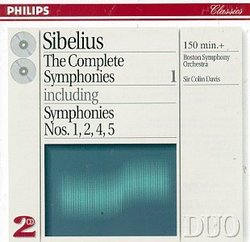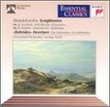| All Artists: Jean Sibelius, Colin Davis, Boston Symphony Orchestra Title: Sibelius: The Complete Symphonies 1 Members Wishing: 0 Total Copies: 0 Label: Philips Release Date: 6/13/1995 Genre: Classical Styles: Forms & Genres, Symphonies, Historical Periods, Modern, 20th, & 21st Century, Romantic (c.1820-1910), Symphonies Number of Discs: 2 SwapaCD Credits: 2 UPC: 028944615722 |
Search - Jean Sibelius, Colin Davis, Boston Symphony Orchestra :: Sibelius: The Complete Symphonies 1
 | Jean Sibelius, Colin Davis, Boston Symphony Orchestra Sibelius: The Complete Symphonies 1 Genre: Classical
As so often happens in the classical record business, Sir Colin Davis has been busily rerecording all of this music for RCA, with the London Symphony. And because he's an English conductor working with an English orchest... more » |
Larger Image |
CD DetailsSynopsis
Amazon.com essential recording As so often happens in the classical record business, Sir Colin Davis has been busily rerecording all of this music for RCA, with the London Symphony. And because he's an English conductor working with an English orchestra, the British critics are raving, as if these earlier, much better, and much less expensive versions didn't even exist. Well, ignore the hype. Not only does the Boston Symphony play rings around today's London Symphony Orchestra (Davis's current group), but they are much better recorded too. This first Sibelius cycle was a prime recommendation when it first came out, and it still is, plain and simple. --David Hurwitz Similarly Requested CDs
|
CD Reviews"Finland, Finland. The Country Where I'd Quite Like To Be" Joseph Kimsey | Pac NW | 06/20/2002 (5 out of 5 stars) "I'm ashamed to say this, but until recently I have avoided Sibelius like the plague. I'm even more ashamed to say this: I avoided him because certain classical music writers/scholars misled me into thinking that his melodic invention was second-rate, his orchestration flabby, and the majority of his works pedestrian. This is all before I even heard a note of the man's music. I'll never make that mistake again! Considering that it has been fashionable to take critical swipes at Beethoven (!) for the last 50 years, it's quite obvious that classical music critics can never be fully trusted. If that were the case, I never would have approached Wagner, Charles Ives, or Anton Webern.I concur with several reviewers in stating that the overall sound of these recordings is excellent. Davis' conducting is very solid & stately. The Boston Symphonic sings this music with such frozen intensity that Symphony #4 can be almost overwhelmingly moving. Personally, I have never noticed any really intrusive noises during Symphony #5. I find that first movement incredible, though. Symphony #2 is more approachable (conventional) with its sprightly-yet-majestic opening movement. Things become darker in the second movement, while the third is somewhat manic and segues directly into a Tchaikovskian last movement. Sibelius' music, for me, epitomizes the nation of his birth: lonely, cold, seemingly unsophisticated to those who don't bother scratching the surface; there are little of the Mozart or Verdi flourishes and warmth that define what "classical" music is all about for most casual orchestral music listeners. Subjectively speaking, however, I much prefer the hardy, profound and expansive terrain of composers like Sibelius or Beethoven to the elegant salons of Verdi or Chopin." Great recordings, great price, skinny packaging John Grabowski | USA | 02/01/2002 (5 out of 5 stars) "Despite recommendations that pop up occasionally for more obscure cycles of the Sibelius symphonies, I find this to be, as a whole, the most fulfilling set. Davis and the BSO play and are recorded beautifully. The early symphonies, though not my favorites, here fare better than they often do because Davis doesn't make them sound like chilly Tchaikovsky. The Fourth gets a terrific reading, both appropriately bleak and, in the slow movement, lyrical and beautiful. Throughout we're aware that Davis isn't *pushing* to make a point...he brings out the music's qualities effortlessly and organically, with a quiet and subtle logic from movement to movement. The Fifth really allows the Boston Symphony to show off its superb colors, and we realize, in the right hands, this is one of the most beautiful, if not *the* most beautiful, in the United States. Davis manages sounds that are thick and plummy where needed (the tympani, for example) but also lean and crystaline where needed (string and often woodwind groupings, for example). He has a sound conception that I feel is ideal for Sibelius. At the price, this is a steal. Although Davis has remade these works recently with the LSO on RCA, this is the cycle to get. The later recordings are less shaped, less focused, and the Londoners don't play as beautifully, nor are they as well-recorded. And at less than half the price for the same amount of music, this set is the best for your wallet too. A desert-island compilation." Master Symphonist stravinskyfanatic | Frederick, MD | 01/27/2000 (5 out of 5 stars) "This 2 CD set (along with the 2nd set by Davis and Boston) is outstanding! Sibelius has taken the symphony to a new level. From the romantic 1st and 2nd, to the dark 4th, to the heroic 5th, each one is a masterpiece of originality. His orchestration and thematic material is quite unique, while the development and form are without parallel. These works are accessible and fun to listen to, but also have incredible depth and intelligence. Invest in Sibelius symphonies, I promise you won't be disappointed."
|

 Track Listings (8) - Disc #1
Track Listings (8) - Disc #1








